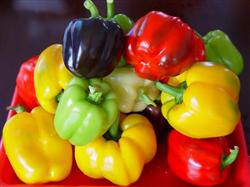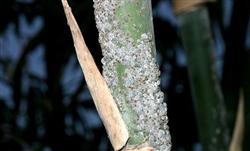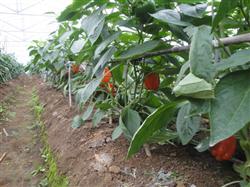How to grow colored sweet peppers?

How to grow colored sweet peppers? Color sweet pepper is a high-yielding hybrid vegetable variety introduced and planted from abroad. It is an excellent variety with international advanced level, with long growth period (harvest time) and high purity (more than 99%). High yield, stable yield, strong disease resistance, good product quality, extremely resistant to storage and transportation, thick pulp, smooth peel and so on. The plant of colored sweet pepper grows vigorously, and the plant height can reach 2.5 to 3.0 meters. The average weight of each fruit of colored pepper is more than 200g, the average yield per mu in high-yield land is about 5000 grams per mu, and the output value is between 20, 000 yuan and 60, 000 yuan. After maturity, the color is divided into milky white, purple red, red yellow, green, orange red, black and so on. The range of vegetables for western food salad has been expanded, and taste and color have added more features to modern cooking. A large number of products are exported to the United States, Japan, South Korea, Western Europe and other countries, especially in recent years, the vigorous development of the domestic service industry has increased the demand for colored peppers. Color pepper seed has high scientific and technological content, and its value is higher than that of other sweet pepper varieties. it belongs to a high-input and high-output planting project. Seminiferous tube and thin tube are needed in planting management in order to achieve rich returns. First, the choice of season: the winter cultivation of color pepper in the protected area is generally sown in the first and middle of July, planted in the middle and late August, and can be harvested continuously from December to June of the following year. During this period, after New Year's Day and the Spring Festival, the market demand for colored pepper products is large, and the price is high and stable. It has higher economic benefit. At the same time, the disease is less and easy to manage in the process of cultivation. Second, variety selection: at present, the varieties of colored pepper suitable for cultivation in protected areas should have varieties with large single fruit, bright color, uniform coloring and tolerance to low temperature and low light. At present, the varieties commonly used in production are Mandy, Tarando, Huang Guiren, Hong Yingda, Huang Taiji, Red Rodin and so on. Third, cultivate strong seedlings: cultivating strong seedlings of the right age with thick leaves, thick green leaves, strong stems and well-developed roots is the key to the high yield of color peppers. Color pepper seedlings are in the high temperature and rainy season in July and August. In order to cultivate strong seedlings, we must use the greenhouse or small arch shed (the following is a small arch shed as an example) to cover the top film and cover the sunshade net to raise seedlings in the form of omentum combination, in order to effectively play the role of sunshade, cooling, and preventing rainstorm. 1. Seed treatment: before sowing, the seeds were sunburned for 1 day or 2 days to promote the seed ripening and improve the germination rate. Then soak the seeds in warm soup, soak the seeds in 55 ℃ warm water and stir continuously until the temperature drops to 30 ℃. In order to effectively prevent virus disease, after scalding and disinfection, soak the seeds in 10% trisodium phosphate solution for 20 minutes, rinse with clean water and accelerate germination. 2. Seed soaking and sprouting: soak the seed in warm soup and soak the seed in 30 ℃ warm water for 8 hours to make the seed fully absorb enough water, then wash the seed coat mucus and drain the surface water of the seed to be sown. When raising seedlings at high temperature in summer, it is generally not suitable to accelerate budding and sow seeds. 3. Sowing and seedling raising: (1) configuration of nutritious soil: in order to ensure the good growth of seedlings, the nutritious soil should have sufficient nutrients to supply the seedling stage and have good water retention and air permeability. The ratio of organic fertilizer, soil and fine sand can be 5%, 3.5% and 1.5% (organic fertilizer should be fully mature, with 20 kg of calcium superphosphate and 1 kg of diammonium phosphate on each side). All the above three ingredients should be sifted and stirred evenly according to a certain proportion, and at the same time, 50% chlorothalonil or carbendazim wettable powder should be mixed according to the proportion of 100%. When the moisture in the nutritious soil can be clustered by hand and can be dispersed when falling from a height of 30 cm, it is appropriate to reduce the amount of fine sand when it is not suitable for agglomeration. When it is not suitable to break up, the amount of soil should be reduced appropriately. (2) High temperature greenhouse: 7-10 days before planting, cover the greenhouse with plastic film after deeply turning the soil and applying base fertilizer, and close all the vents of the greenhouse for 3-4 days. The temperature in the soil layer can reach 60 ℃ ~ 70 ℃ at noon on a sunny day, which can play a good role in disinfection and sterilization. (3) soil preparation and ridging: for overwintering cultivation of color pepper, ridging cultivation should be adopted to improve the soil temperature, and the soil should be ploughed more than 30 cm deep before the high temperature shed, combined with the application of fully mature chicken manure 5000kg / mu or soybean meal organic fertilizer 1500kg / mu, 200kg compound fertilizer, 2kg biological potash fertilizer, 2kg biological bacterial fertilizer resistant to Verticillium wilt and so on. After leveling the ground, ridging is carried out, the ridge is 30 cm wide and 20 cm high, the small groove between the two ridges is 20 cm wide, the working road width is 50 cm, and finally forms a small row spacing of 50 cm, a large row spacing of 80 cm, and a plant spacing of 50 cm. About 2000 plants are planted per mu. Click to get more sweet pepper planting techniques click to get more vegetable planting techniques
- Prev

What diseases and insect pests need to be controlled in planting bamboo shoots?
What diseases and insect pests need to be controlled in planting bamboo shoots? Please introduce the control methods for planting bamboo shoot diseases and insect pests as follows: 1. Pest control: the main pests of bamboo shoots are aphids and bamboo borer. Aphids occur more than ten generations a year, and generations overlap. July-September is the peak period, often clustered in tender.
- Next

How to remove the sweet pepper razor?
How to remove the sweet pepper razor? Please introduce that in the production process of a large crop of sweet pepper, many vegetable farmers are accustomed to removing all the seeds from the plant before setting fruit, resulting in insufficient nutrition supply and difficult fruit setting of sweet pepper. Recently, the reporter in Shouguang city street Yangzhuang village vegetable farmer Xiao's greenhouse.
Related
- Where is it suitable to grow horseradish in China? it is expected to see the middle altitude horseradish in Alishan.
- How to prevent tomato virus disease reasonably? (Control methods included)
- Many people like to plant towel gourd on the balcony. What are the main points of this method and management?
- What crops can chili peppers be mixed with?
- Fertilization techniques and matters needing attention in Tomato
- What are the grafting techniques for peach seedlings in spring?
- Harm and control methods of root swelling disease of Chinese cabbage
- What are the pests of sweet potatoes? How to prevent and cure it?
- Symptoms, causes and Control methods of navel Rot in Tomato
- The cause of "Cucumber rotten bibcock" in Farmers' planting Cucumber and its Control Plan

